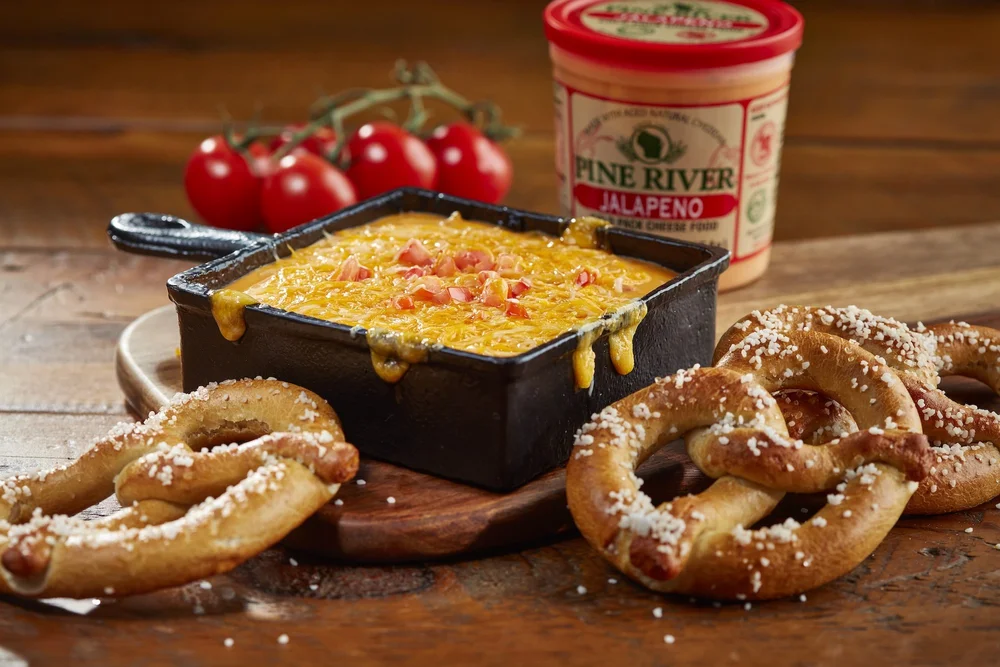A cheese spread is a cheese spread is a cheese spread, right? Except, there’s a big difference between most cheese spreads and cold pack cheese spreads. Read more about cheese spreads from around the world.
Mary Lindemann 
Most cheese spreads are treated with heat. They’re either pasteurized, cooked or injected with heat, says Mary Lindemann, marketing director at Pine River, a leading maker. This changes the taste and texture, she says. Cold pack, on the other hand, is created by blending real cheese and other ingredients, but, as its name suggests, there’s absolutely no heat involved. “It’s blended without heat, and that’s the key part of cold pack,” Lindemann says. “It’s like putting regular cheese in a spreadable form.”
As such, cold pack cheese spreads have a more intense flavor that tastes rather like the cheeses they’re made from. “When you heat the cheese in any way, it changes the texture, and it can change the flavor,” Lindemann says. “You know how when you cook vegetables, they taste one way raw, and another way cooked? It’s the same with cheese spreads.”
The taste and texture differences between cold pack cheese spreads and regular cheese spreads isn’t imagined. Professors at Utah State University proved it with research details in the report, Grittiness in a Pasteurized Cheese Spread: A Microscopic Study. According to Lindemann, “The study revealed that pasteurizing the cheese spread compacts the protein molecules, causing “grittiness.” She adds, “The unpasteurized (unheated) cold-pack cheese spread prepared from the same ingredients was smooth with no grittiness defect.”
History of Cold Pack
Kaukauna spreadable cheese
Cold pack cheeses were invented in Wisconsin during the height of the Great Depression. Hubert Fassbender, who ran a beer depot and had his own dairy distribution company, started giving some of his customers a blend of spreadable cheese and beer, probably made from leftover bits and pieces of cheese, and customers began asking for the cheese without the beer. Sold in crocks, the cheese became very popular in supper clubs and taverns and is also known as crock cheese and club cheese.
In 1933, Fassbender’s brand became Kaukauna Klub cold pack cheese. Other cheese manufacturers and companies started doing their own versions of cold pack, and the snack spread throughout America’s Dairyland, where it’s now an iconic food product by itself. The name cold pack refers to the method by which it’s made. To make a cold pack spread, Pine River starts out with natural cuts of regular cheese. Lindemann explains the cheese blended with butter, whey, spices and flavorings–always without heat. Because the cheese is not heat processed, it must be refrigerated and unlike heat processed cheese spreads, it is not shelf stable.
Variations of Cold Pack Cheese
Selection of Pine River Cold Pack 
Like some other producers of cold pack spreads, Pine River also makes heat-treated cheese spreads. This allows them to be added to gift baskets, but it also allows them to be sold in stores without a lot of refrigeration space. “We take our cold pack recipe, and we inject heat in it,” Lindemann says. “It gives it a 600-day shelf life. The texture is different from the cold pack. It’s a little bit slippery, but the flavor is still very good, and it melts really well.”
Lindemann says Pine River evolved to include their line of heat-treated spreads because of their involvement in the fundraising industry. “We couldn’t count on kids to take the spreads home and out of their locker,” she says. “That’s where it started, but the business is growing, not just in holiday or corporate gift baskets, but it’s also spreading to places like gas stations and liquor stores, stores that can cross merchandize. We sell a cardboard container with four different cheese spreads, and stores can customize which spreads to include in the box.”
Shelf stable spreads are also good for car trips and travel, but Lindemann advises that if you’re flying to put them in your checked luggage. “You can’t bring it on an airplane, as it is considered a liquid,” she says, adding that once you open a container of shelf-stable spread, you should refrigerate, that is, if you don’t eat it all in one sitting.
Specialists in cold pack like Pine River offer the product in many flavors, including Port wine, cranberry cheddar, spicy beer and more. They also partner with a wide variety of cheesemakers to custom make cold pack including Cabot Creamery and Widmer’s Cheese Cellars. Traditionally sold in crocks, today it’s available in plastic tubs. Some producers such as Kaukauna also sell it rolled in nuts and formed into balls or logs.
Cooking with Cold Pack
A convenient product for entertaining, it’s also the basis for cheese balls and can be used in dips and snacks. Lindemann shares these popular recipes:
Pine River Jalapeño Cheese Dip
Pine River Jalapeño Cheese Dip
Ingredients
2 8oz containers Pine River Jalapeño Spread Cheese
3 green onions, diced
¼ C mild salsa or diced tomato
¼ C diced red pepper
1/2C shredded cheddar cheese
Tortilla chips or pretzels for serving
Instructions
Heat oven to 350F. In a mixing bowl combine Pine River Jalapeño Cheese, onions, salsa or tomato and diced red pepper. Mix to combine and place in a small baking dish. Top with cheddar. Bake for 15 minutes until the cheese is melted and heated through. Remove from heat. Serve with chips or pretzels. Enjoy!
Holiday Tortilla Pinwheels
Holiday Pinwheels .jpg?format=1000w)
Ingredients
2 8oz containers Pine River Garlic & Herb Cold Pack Cheese Spread
3/4 cup dried cranberries
4 green onions thinly sliced
3/4 pound thinly sliced deli ham
6 10” burrito size flour tortillas or wraps (use a variety of colors)
Directions
Divide Pine River Garlic & Herb Cheese Spread evenly between 6 tortillas, spreading out in a thin layer to within 1/2” of the edge. Sprinkle each tortilla with cranberries and green onions. Layer on some ham and roll up tightly. Wrap roll-ups tightly in plastic wrap and refrigerate for one hour. Cut off and discard the uneven ends and slice each roll-up into 6 pieces.
